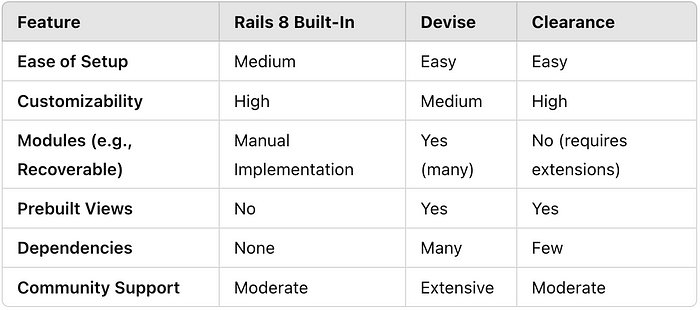Rails 8 Authentication: Devise vs Clearance vs Built-In Options
 NonStop io Technologies
NonStop io Technologies
Authentication is a critical component of any web application. With the release of Rails 8, developers have multiple options for integrating user authentication into their applications. This blog will compare the built-in authentication features of Rails 8, the popular Devise gem, and the minimalist Clearance gem. We will cover how to integrate each option, compare their features, and help you decide which is the best fit for your project.
1. Rails 8 Built-In Authentication
Rails 8 introduces an in-house authentication solution called Rails Authentication. This approach provides:
Lightweight implementation: Focused on simplicity and convention over configuration.
No external dependencies: Fully integrated with Rails, reducing compatibility concerns.
Customizability: Offers flexibility in writing authentication logic according to your application’s specific needs.
How to Integrate
Rails 8 authentication can be implemented using Active Record and Rails’ built-in tools. Here’s a step-by-step guide:
1. Generate a User model:
rails generate model User email:string password_digest:string
2. Add has_secure_password to the User model:
In Rails, the has_secure_password method provides an easy way to securely hash and authenticate passwords, leveraging the bcrypt gem. Here's a quick rundown of how it works:
What
has_secure_passwordDoes:Password Hashing*: It hashes passwords using BCrypt, which is a slow and computationally expensive algorithm, making it resistant to brute-force attacks.*
Password Confirmation*: Automatically adds validation to ensure the*
passwordandpassword_confirmationfields match (ifpassword_confirmationis present).Password Authentication*: Adds an*
authenticatemethod to verify the password.
class User < ApplicationRecord
has_secure_password
validates :email, presence: true, uniqueness: true
end
3. Set up routes and controllers:
# config/routes.rb
resources :sessions, only: [:new, :create, :destroy]
# app/controllers/sessions_controller.rb
class SessionsController < ApplicationController
def create
user = User.find_by(email: params[:email])
if user&.authenticate(params[:password])
session[:user_id] = user.id
redirect_to root_path, notice: "Logged in successfully."
else
flash.now[:alert] = "Invalid email or password."
render :new
end
end
def destroy
session[:user_id] = nil
redirect_to root_path, notice: "Logged out."
end
end
4. Secure passwords with BCrypt: Rails’ built-in has_secure_password relies on BCrypt for hashing passwords.
2. Devise Gem
Devise is one of the most popular authentication libraries for Rails. It provides a comprehensive suite of features out of the box:
Modules for extended functionality: Registerable, Recoverable, Rememberable, Confirmable, and more.
Out-of-the-box views: Includes prebuilt views for sign-up, login, password recovery, etc.
Highly configurable: Allows customization of controllers, routes, and views.
How to Integrate
1. Add Devise to your Gemfile:
gem 'devise'
Run bundle install.
2. Install Devise:
rails generate devise:install
Follow the installation instructions provided in the console output.
3. Generate a User model with Devise:
rails generate devise User
rake db:migrate
4. Customize views (optional):
rails generate devise:views
This will copy Devise’s views into your application, allowing you to modify them as needed.
5. Protect specific routes:
Use the before_action filter in your controllers:
before_action :authenticate_user!
3. Clearance Gem
Clearance is a minimalist authentication gem by Thoughtbot. It is simpler than Devise, focusing on the essentials:
Lightweight: Provides only basic authentication features like sign-up, sign-in, and password management.
Extensible: Allows customization without enforcing a specific structure.
Rails-like conventions: Aligns closely with Rails principles.
How to Integrate
1. Add Clearance to your Gemfile:
gem 'clearance'
Run bundle install.
2. Install Clearance:
rails generate clearance:install
3. Run migrations:
rails db:migrate
4. Modify routes (optional):
Customize your application’s routing if needed:
Clearance.configure do |config|
config.routes = false
end
Then define your own routes.
5. Use helpers in views:
<% if signed_in? %>
Welcome, <%= current_user.email %>
<% else %>
<%= link_to 'Sign In', sign_in_path %>
<% end %>
Feature Comparison

Which One Should You Choose?
Rails 8 Built-In:
Choose this if you want complete control over your authentication logic and minimal dependencies. Ideal for projects that need lightweight, custom authentication.
2. Devise:
Go for Devise if you need a robust, feature-rich solution that works out of the box. Perfect for applications where speed of implementation is critical and default modules meet your needs.
3. Clearance:
Opt for Clearance if you prefer a simple, minimalist solution with flexibility to extend as needed. Best for projects where you need a lightweight framework but want more control than Devise offers.
Final Thoughts
Choosing the right authentication solution depends on your application’s requirements, team expertise, and the level of customization you need. Rails 8 built-in authentication is a great option for those who value flexibility, while Devise and Clearance cater to developers looking for quick implementations or minimalist solutions, respectively.
We hope this guide helps you make an informed decision.
Subscribe to my newsletter
Read articles from NonStop io Technologies directly inside your inbox. Subscribe to the newsletter, and don't miss out.
Written by

NonStop io Technologies
NonStop io Technologies
Product Development as an Expertise Since 2015 Founded in August 2015, we are a USA-based Bespoke Engineering Studio providing Product Development as an Expertise. With 80+ satisfied clients worldwide, we serve startups and enterprises across San Francisco, Seattle, New York, London, Pune, Bangalore, Tokyo and other prominent technology hubs.